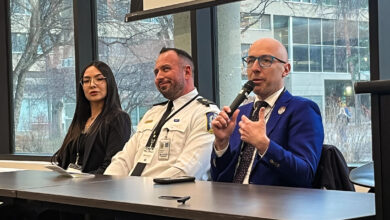U of A weighs pros and cons of teaching tenure
 Danika Kunimoto
Danika KunimotoFuture students at the University of Alberta may be sitting in classrooms of professors hired to focus on teaching.
The U of A currently only appoints professors to divide their time between research and teaching. In the January 25 sitting of the Committee on the Learning Environment, university members considered the possibility of introducing a system of hiring professors to teach.
Students’ Union President Fahim Rahman presented a comparison of teaching tenureships at other Canadian universities. Investigating the possibility of a teaching tenure system was one of Rahman’s platform points when he ran for SU Vice-President (Academic) two years ago.
“I took on this project because I knew that the U of A is a research and teaching-intensive institution,” he said. “But in our recent strategic plans I think there’s been a heavy emphasis on research.”
Many Canadian universities have a teaching tenure, including the Universities of British Columbia, Toronto, and Calgary. Titles of professors tenured for teaching range from “Teaching Track” to “Instructor” and include ranks such as assistant lecturer and senior lecturer. Some teaching streams allow professors to conduct research as well.
Committee members raised concerns about professors tenured for teaching being seen as second-class. One member questioned why the position should be given a different title than more research-focused professors if they’re truly meant to be equal. Another was concerned that teaching-focused professors would be disadvantaged when applying for research grants and that their career mobility could be negatively affected.
While no firm answers to these questions were reached by the committee, Rahman said he hopes to approve a document at General Faculties Council in March outlining teaching streams at other universities and some recommendations from the committee that the university can use if they decide to create a teaching stream.
Committee member Mani Vaidyanathan, an associate professor of engineering, said a teaching stream is generally a good idea.
“Part of the motivation for a position like (teaching tenure) is to recognize and encourage people who are good at explaining complicated things,” he said. “To acknowledge that has tremendous value.”
Having a teaching stream would give professors who can explain new advances in their field the time to focus on teaching, Vaidyanathan added.
“One of the problems with teaching is that professors simply don’t have enough time,” he said. “We have so many responsibilities, there’s only so much time that we can devote to it.”
It’s unclear how salaries for teaching tenure would be dealt with at the U of A — Rahman found salaries for teaching-focused professors at other universities ranged from $90,000 to $250,000. Vaidyanathan said if teaching-focused professors aren’t paid the same as their research-focused counterparts, the two won’t be seen as equal.
“I think you’ll find that the people who choose to do the teaching stream are highly qualified and talented people,” Vaidyanathan said. “This is a choice that they’re making.”





This is a critical issue, particularly for undergraduate students who constitute the vast majority of the citizens of the University. Research, publishing and achieving tenure have been the primary foci of faculty to date – “publish or perish” has meant that teaching, which is the primary interface with undergraduate students has been done ‘off the side of faculty desks’. University faculty usually receive no training, and are not adequately vetted for teaching skills, which are not a natural ability. It’s time teaching was valued as a primary focus of the University’s mandate, and a primary skill for faculty who interact with undergraduates. Whether to achieve that through a teaching ‘ghetto’, or by valuing it more for all faculty is a tough question. Can we do both?